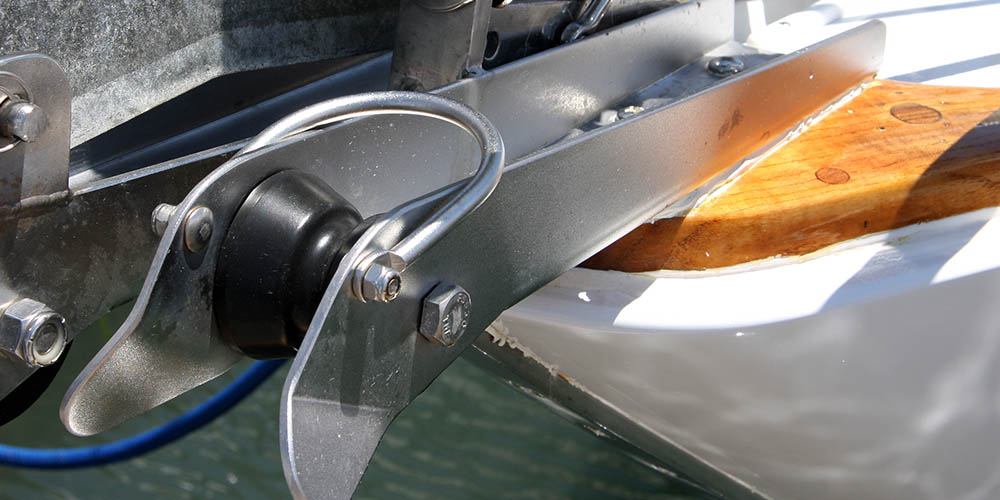
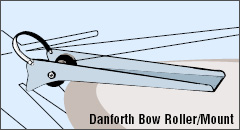
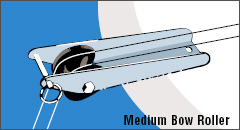
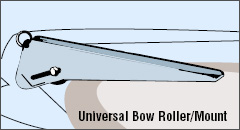
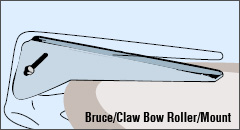
- What Anchor Rollers Do
- How Anchor Rollers Work
- Choosing the Right Anchor Roller
- Securing the Anchor to the Bow Roller
What Anchor Rollers Do
Anchor rollers provide a rolling surface that makes it easier to drop and weigh anchors without banging up your topsides. Anchor roller/mounts allow you to stow your anchor conveniently after you weigh it.
How Anchor Rollers Work
Anchor rollers make it easier for you to weigh anchor by hand since you can place your body where you can pull most efficiently. They also create a fair lead for the anchor rode so it doesn't chafe against your stem fitting or chocks. The rolling action reduces chafe as the nylon line stretches.
Anchor mounts cradle the anchor on the bow of the boat so that it's always ready for deployment (a basic tenet of good seamanship). They are practically required when your boat is equipped with a windlass, since they guide the anchor rode to the windlass gypsy, and keep chain from gouging your hull and deck.
Powerboats commonly place anchor mounts on their centerline, since they have no head-stays. Sailboats, with stem fittings, head stays, furling drums, bow pulpits, etc. should have mounts placed 4"-8" to the right (or left) of the head-stay. Wooden blocks may be required to raise the mount above the toe rail. It should be parallel to the centerline of the boat, however, and aligned with the windlass gypsy.
Choosing the Right Anchor Roller
Your anchor roller must be compatible with your style and size of anchor to accommodate the shank of the anchor and to keep the anchor far enough away from the bow so the plow or claw of the anchor does not damage the bow when the anchor is fully retrieved and stored. Check with the manufacturer of the bow roller to see what anchors are compatible with the model you are interested in. If you frequently switch between different types of anchors due to different bottom types, then a universal anchor roller is a good option. While a universal roller will not fit all anchors, they still offer some versatility.
Securing the Anchor to the Bow Roller
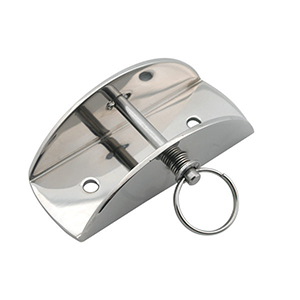
Lewmar's anchor chain lock is a great way to secure your anchor when underway.
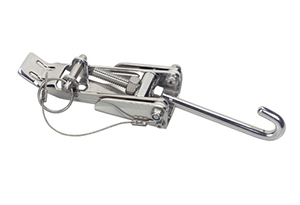
An anchor chain tensioner, like this model from Lewmar, takes the slack out of the chain and snugs the anchor up against the bow roller.
Your windlass should not be used to hold the weight of your stored anchor because it can cause unnecessary strain on the windlass and could cause your windlass to slip, suddenly releasing your anchor in the process. Always make sure that your anchor is properly secured when underway using one of these methods.
- Install an anchor lock: Anchor locks consist of a bracket and a pin. The bracket is mounted to the deck behind the anchor roller and the pin slides through a link in the chain to take strain off the windlass and avoid accidental deployment.
- Secure the anchor rode to a cleat on deck: Quick, simple and effective, securing your anchor rode to a cleat on deck is a good way to avoid sudden anchor deployment.
- Install a chain tensioner: Chain tensioners consist of a hook that connects to a link in the anchor chain and a lever that when locked down pulls on the chain to take out slack and snug the anchor up against the bow roller.
Whatever method you choose, always make sure that the anchor is secure before you start moving. The few seconds it takes to secure the anchor is well worth the peace of mind that your anchor will not damage the windlass or drop suddenly.
Anchor Roller FAQ
An anchor roller allows for smooth deployment and retrieval of your anchor, minimizing damage to the boat’s topsides. It also serves as a convenient cradle to store the anchor securely at the bow when not in use.
The roller guides the anchor rode along a smooth, fair lead, preventing contact with sharp deck fittings or the stem. This reduces friction, especially when the rode stretches, minimizing wear on the line or chain.
Most powerboats and sailboats can accommodate anchor rollers, but placement differs. Powerboats typically mount them on the centerline, while sailboats may need to offset the roller and use risers to clear bow fittings or pulpits.
Anchor rollers must be matched to your anchor’s style and size. Make sure the shank fits the roller’s channel and that the roller keeps the anchor’s flukes or claw away from the hull. Always consult the roller manufacturer for compatibility guidance.
Universal anchor rollers are designed to work with a variety of anchor types. While they may not fit every design perfectly, they offer flexibility for boaters who use different anchors depending on bottom conditions or cruising needs.
No. Your windlass should not bear the weight of the stored anchor while underway. This can stress the mechanism and cause unintentional anchor deployment. Always secure the anchor with a chain lock, cleat, or chain tensioner.
An anchor lock uses a pin and bracket to secure a link in the chain, holding the anchor in place. A chain tensioner hooks onto the chain and uses lever action to tighten and snug the anchor against the roller, eliminating slack.
Yes. Tying off the anchor rode to a cleat is a simple and effective method of securing the anchor. It prevents movement and protects your windlass and bow from sudden deployment or shock loads in rough conditions.
Yes. Even without a windlass, a bow roller makes it much easier and safer to handle your anchor. It provides a stable, aligned pulling point, reduces strain on your body, and prevents deck damage during anchor retrieval and storage.
The roller must be aligned with the centerline of the boat and the windlass gypsy to prevent the anchor rode from chafing or binding. Poor alignment can lead to inefficient anchoring and damage to the roller or hull over time.